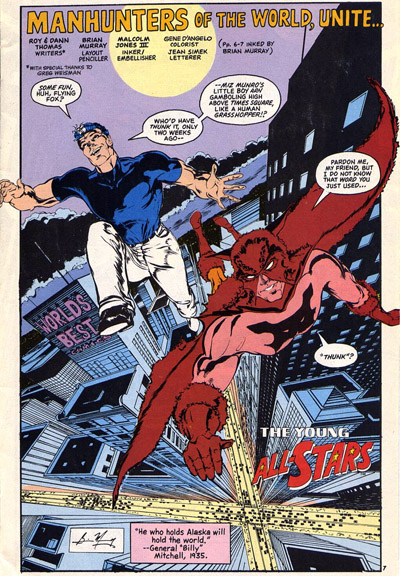Who's This? Who's Who's sole Canadian hero.
The facts: When Crisis erased the Golden Age versions of Superman, Batman, et al. from continuity, Roy Thomas filled the void with similar young heroes debuting in Young All-Stars #1 (1987). The Flying Fox is the most dissimilar to the hero he replaced - Batman! There's still the murder of a parent, a cave, and a basic silhouette with cape and cowl, but otherwise, a magic-fuelled Canadian Native with other elements seemingly pulled from Nelvana of the Northern Stars (just as Marvel's Snowbird was) is pretty far afield of the Caped Crusader. It's not even close to one possible inspiration - a flying ace from More Fun Comics #37-51. He featured in most of Young All-Stars' 32 issues, then disappeared.How you could have heard of him: Aside from background appearances when flashbacking to the Young All-Stars (rare), a version of Flying Fox appeared manning the phones in the parodic One-Star Squadron mini-series. Whether or how he could be the same person as the 1940s hero is not addressed. Lucas Fox, AKA Batwing, at one point used the Flying Fox IP, but that's not the same.
Example story: Young All-Stars #8 (January 1988) "Manhunters of the World, Unite..." by Roy & Dann Thomas, Brian Murray and Malcolm Jones III
First off, a greeting: Happy Canada Day. Second, an admonishment: While Alpha Flight ensured that the Marvel Universe would consistently produce Canadian superheroes, the DCU has only rarely minted one, despite half of Superman's DNA coming from the Great White North. The original run of Who's Who, including Updates, has only two Canadian characters, one of them the villain Plastique. Later attempts to retcon American heroes into Canadian ones don't count (Adam Strange, Booster Gold of all people), and very minor original characters never got Who's Who entries (Lumberjack, Centrix, Freight Train). Closest we get are Equinox and Sparx. So Flying Fox is necessarily a "big deal" (but still in quotation marks). And yes, I've picked a Millennium issue, but Flying Fox get a share of the action (there's no real SPOTLIGHT issue for him).
The Flying Fox was raised in a "secret village" in the Arctic, so he's played as being confounded by slang and things like advertising. And he speaks a bit like Thor. Or the Martian Manhunter. Maybe it's the way he "senses" Iron Munro's feelings.
We get a very good look at the mask here, which (perhaps strangely) harks to his connection to Batman. The boys race to the Perisphere where the Manhunters (secretly working for the space Manhunters well ahead of the "Millennium") soon arrive to warn the Young All-Stars that Green Lantern has gone crazy and is rampaging in Hawaii. A robot Doiby Dickles is also in the party to give the story credibility. From Hawaii, Alan Scott has flown to Alaska, so the kids have Hop Harrigan fly them there to stop GL from terrorizing a First Nations tribe with visions of some death goddess. As the fight begins, Fox shows more of his Batman DNA by using his brain rather than his brawn:
But alas, Green Lantern isn't out for the count.
Not a great showing for any of the team, but I gotta admit, the Flying Fox hole in the snow is pretty funny.
The humor of the situation is lost on Alan Scott when he wakes up though. And then the ring's power takes hold again and he's off to Parallax someone else.
As for the Flying Fox, he was hampered by the fact that his story was set in the 1940s. Since few continuing comics ever go there, it didn't give him much room to breathe. Other heroes HAVE appeared as part of younger heroes' legacies (like Iron Munro, and recently the Dyna-Mite), but for the most part, the Young All-Stars have become a footnote. And I wouldn't say "deservedly".
Who's Next? A potential boyfriend for Barbie.








Comments